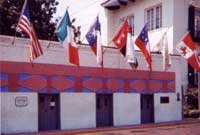Leaders in the northern Mexican states of Coahuila, Nuevo León and Tamaulipas met in Laredo on 17 January 1840 and declared independence as the Republic of the Río Grande. They hoped to gain independence from the central Mexican government as Texas had done in 1836. Unfortunately for the infant republic, the state legislatures in the three states did not support their rebellion.
The new government of the Republic of the Río Grande moved often to avoid being captured by the Mexican federal troops. They started in Laredo, the republic’s initial capital, but in the first few weeks moved to Guerrero, Tamaulipas. Next they moved to Victoria in the new Republic of Texas, where it remained.
The insurgent forces, under General Canales were composed of state militias from the three states and volunteers from the Republic of Texas, which was sympathetic to the cause of the Republic of the Río Grande, but unwilling to jeopardize their new independence by officially recognizing and providing troops to the Republic of the Río Grande.
The insurgents and federal forces battled several times during the middle of 1840. When the federal forces won the March 24–25 Battle of Morales (Coahuila), the surviving insurgents, under General Canales, retreated to San Antonio, Texas. In June, a group of insurgents under Colonel Jordan captured Ciudad Victoria, the capital of Tamaulipas, and had ideas of marching on San Luis Potosí. Instead they marched to Saltillo and in October attacked the federal forces there. From there they retreated back into Texas.
After that battle, it became clear that the insurgent forces could not sustain the rebellion. On November 6, 1840 the Republic of the Río Grande ended when General Canales agreed to end the rebellion in exchange for a brigadier general position in the federal army. The short-lived republic lasted a total 294 days.Additional information is available at the Republic of the Rio Grande Museum in Laredo (photo).
The evolution of Mexico’s political boundaries is discussed in chapter 12 of Geo-Mexico: the geography and dynamics of modern Mexico.

Sorry, the comment form is closed at this time.